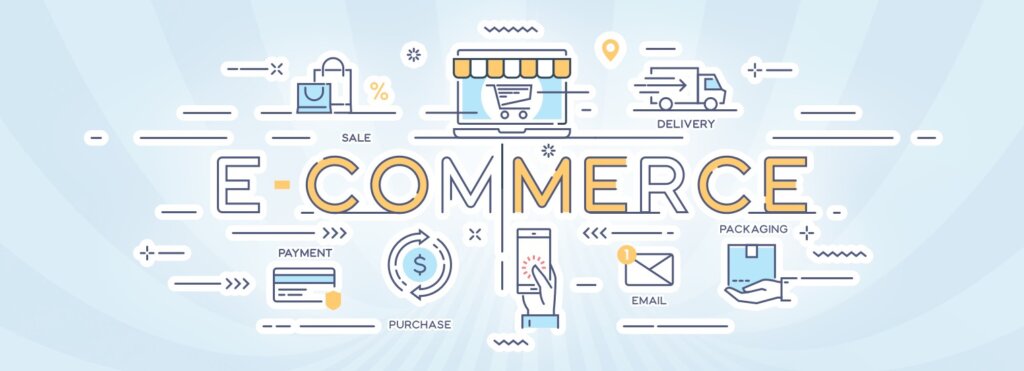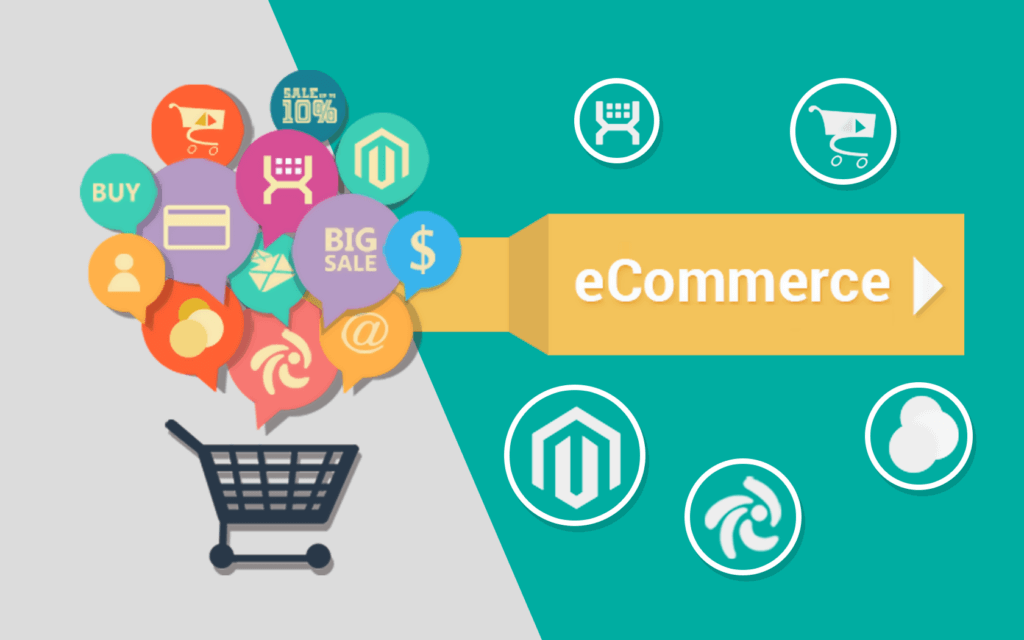eCommerce
Introduction to eCommerce:
eCommerce, or electronic commerce, refers to buying and selling goods or services online. It is a rapidly growing industry that has transformed how businesses operate and has become an increasingly popular option for consumers and businesses. Here’s a look at the history of eCommerce, what it is, and why it matters.
A brief history of eCommerce:
The roots of eCommerce can be traced back to the 1960s when companies began using Electronic Data Interchange (EDI) to exchange business documents electronically. In the 1990s, the first online marketplaces and storefronts were created, paving the way for the eCommerce industry as we know it today. Amazon was one of the first significant eCommerce companies to emerge, followed by other giants such as eBay and Alibaba.
What is eCommerce?
eCommerce involves buying and selling products or services online. Customers can browse products, make purchases, and pay through online payment systems. eCommerce businesses can operate through various channels, including online marketplaces, standalone websites, and social media platforms. eCommerce has many advantages for businesses, including the ability to reach a global audience, reduced overhead costs, and increased Flexibility.
Why eCommerce matters:
eCommerce has become an essential part of the modern business landscape. Here are some of the reasons why issues of ecommerce:
- Convenience: eCommerce allows customers to shop from the comfort of their homes or anywhere with an internet connection. This makes it more convenient for customers to purchase products and services without leaving their homes or offices.
- Global Reach: eCommerce businesses can reach customers worldwide, enabling them to tap into new markets and expand their customer base.
- Lower Overhead Costs: eCommerce businesses can reduce overhead costs by eliminating the need for physical storefronts and reducing labor costs associated with traditional retail operations.
- Increased Flexibility: eCommerce businesses can quickly adapt to changing market conditions and customer needs, allowing them to stay ahead of the competition.
eCommerce has revolutionized how businesses operate, providing many benefits for businesses and consumers. As technology continues to evolve, we can expect to see even more innovations in the eCommerce space, such as advancements in mobile commerce, artificial intelligence, and blockchain technology. As eCommerce continues to grow and evolve, it will remain an essential part of the modern business landscape.
Setting up an eCommerce Business
Starting an eCommerce business can be a great way to become an entrepreneur and reach a broad audience. However, creating an eCommerce business requires careful planning and execution. Here are some critical steps to take when setting up an eCommerce business.
Choosing a product to sell:
The first step in setting up an eCommerce business is choosing a product to sell. Selecting a product you are passionate about with market demand is essential. Conduct market research to identify products in high demand and with a strong potential for profitability.
Understanding your target audience:
Once you have chosen a product, it’s essential to understand your target audience. Conduct research to identify your ideal customer, including demographics, preferences, and shopping habits. This information will help you create a marketing strategy that resonates with your target audience.
Creating an eCommerce website:
An eCommerce website is a crucial component of any eCommerce business. Here are the steps to create an eCommerce website:
- Choose a domain name and hosting provider: Choose a domain name that is easy to remember and reflects your brand. Select a hosting provider that can handle the traffic to your website.
- Design the website: Your website should be user-friendly and visually appealing. It should also be optimized for mobile devices.
- Set up payment gateways: You need to set up payment gateways to enable customers to purchase on your website. Popular payment gateways include PayPal, Stripe, and Authorize.net.
- Add product pages: Create detailed product pages that include product descriptions, pricing, and images.
Creating a marketing plan:
A marketing plan is essential to promote your eCommerce business and attract customers. Here are some critical elements of an effective marketing plan:
- Social media marketing: Use social media platforms like Facebook, Instagram, and Twitter to promote your products and engage with customers.
- Search engine optimization (SEO): Optimize your website for search engines by using keywords, creating high-quality content, and building backlinks.
- Pay-per-click advertising (PPC): Use PPC ads to target specific keywords and audiences.
- Email marketing: Build an email list and send regular emails to subscribers with updates and promotions.
Starting an eCommerce business requires careful planning and execution. It’s essential to choose a product with market demand, understand your target audience, create an eCommerce website, and develop a marketing plan. Following these steps, you can set up a successful eCommerce business that reaches a broad audience and generates revenue.
Managing an eCommerce Business:
Managing an eCommerce business requires a different approach than working in a traditional brick-and-mortar business. Here are some key elements to consider when executing an eCommerce business:
Managing inventory:
Managing inventory is an essential part of running an eCommerce business. You must ensure you have enough stock to meet customer demand while minimizing inventory costs. Use inventory management software to track inventory levels and automate the process of reordering products when necessary.
Handling customer orders:
Handling customer orders is a critical part of managing an eCommerce business. To maintain customer satisfaction, you must ensure that orders are processed quickly and accurately. Use an order management system to track orders, manage shipments, and handle returns and refunds.
Shipping and delivery:
Shipping and delivery are crucial components of eCommerce. Customers expect fast and reliable shipping, so choosing a shipping partner to deliver products quickly and efficiently is essential. Consider using multiple shipping partners to provide customers with various shipping options.
Managing customer reviews and feedback:
Managing customer reviews and feedback is essential to an eCommerce business. Customer reviews provide valuable insights into customer satisfaction and can help you improve your products and services. Encourage customers to leave reviews and respond to reviews in a timely and professional manner.
Managing returns and refunds:
Managing returns and refunds are an essential part of managing an eCommerce business. It would help if you had clear policies and procedures for handling returns and refunds to ensure that customers are satisfied and your business is protected. Use a returns management system to automate taking returns and refunds.
Managing an eCommerce business requires careful attention to detail and a focus on customer satisfaction. You must manage inventory, handle customer orders, ship products quickly and efficiently, manage customer reviews and feedback, and handle returns and refunds. By prioritizing these elements, you can ensure that your eCommerce business runs smoothly and provides a positive customer experience.
eCommerce Security and Legal Issues:
eCommerce security and legal issues are critical considerations for any eCommerce business. Here are some key elements to consider when addressing eCommerce security and legal issues:
Protecting customer data:
Protecting customer data is one of eCommerce businesses’ most important security considerations. You must ensure that customer data, including personal information and payment details, is protected from unauthorized access or use. Use encryption technologies to protect sensitive data and ensure your website is secure and protected by a robust security system.
Payment security:
Payment security is another critical element of eCommerce security. You must ensure that payment transactions are secure and that customer payment information is protected from unauthorized access. Use safe payment gateways and implement fraud detection and prevention measures to protect against fraudulent transactions.
Dealing with fraud:
eCommerce businesses are vulnerable to fraud, resulting in financial losses and reputation damage. Implement fraud detection and prevention measures, such as fraud screening software and verifying customer identities, to protect against fraudulent transactions.
Legal issues in eCommerce:
eCommerce businesses are subject to a variety of legal requirements and regulations. Some of the critical legal issues to consider include the following:
- Sales tax: eCommerce businesses must comply with sales tax regulations, which vary by state and country.
- Privacy policies: eCommerce businesses must have a comprehensive privacy policy explaining how customer data is collected, used, and protected.
- Intellectual property: eCommerce businesses must ensure that they are not infringing on the intellectual property rights of others, such as trademarks and copyrights.
eCommerce security and legal issues are critical considerations for any eCommerce business. You must protect customer data, ensure payment security, and prevent fraud. Additionally, eCommerce businesses must comply with various legal requirements and regulations, such as sales tax, privacy policies, and intellectual property rights. By prioritizing these elements, you can ensure that your eCommerce business operates legally and securely.
Future Trends in eCommerce:
eCommerce is a rapidly evolving industry, with new technologies and trends constantly emerging. Here are some of the future trends in eCommerce to keep an eye on:
Mobile commerce:
Mobile commerce, or m-commerce, is the buying and selling goods and services through mobile devices. With the growing use of smartphones and tablets, m-commerce is expected to become an increasingly important part of eCommerce. To stay competitive, eCommerce businesses must optimize their websites and payment systems for mobile devices and offer a seamless mobile shopping experience.
Artificial intelligence and chatbots:
Artificial intelligence (AI) and chatbots are revolutionizing eCommerce by providing personalized shopping experiences and improved customer service. AI-powered recommendation engines can help customers find products that meet their needs, while chatbots can provide real-time support and assistance. eCommerce businesses can leverage these technologies to improve customer satisfaction and increase sales.
Augmented reality:
Augmented reality (AR) is a technology that superimposes digital content onto the real world, allowing customers to visualize products in their environment. AR has the potential to revolutionize eCommerce by enabling customers to see products in a more immersive and engaging way. eCommerce businesses can use AR to provide customers with a more interactive shopping experience and increase customer engagement.
Blockchain technology:
Blockchain technology is a decentralized digital ledger that can verify and secure transactions. Blockchain has the potential to revolutionize eCommerce by providing safe and transparent transactions and eliminating the need for intermediaries. eCommerce businesses can use blockchain to increase transparency, reduce fraud, and improve the security of their transactions.
eCommerce is a rapidly evolving industry constantly adapting to new technologies and trends. Mobile commerce, artificial intelligence and chatbots, augmented reality, and blockchain technology are some future trends expected to shape the eCommerce landscape. By staying ahead of these trends and leveraging new technologies, eCommerce businesses can provide a better shopping experience for customers and stay ahead of the competition.
Conclusion:
eCommerce has transformed how businesses operate and has become an essential part of the modern business landscape. To succeed in eCommerce, companies must prioritize customer satisfaction, adopt new technologies and trends, and comply with legal requirements and security measures. By doing so, eCommerce businesses can reach a global audience, reduce overhead costs, and provide a better shopping experience for customers.
F.A.Q
What are the four types of e-commerce?
The four types of e-commerce are:
- Business-to-Consumer (B2C) e-commerce is the most common type of e-commerce, where businesses sell products or services directly to individual consumers through online storefronts or marketplaces.
- Business-to-Business (B2B) e-commerce: This type of e-commerce involves businesses selling products or services to other companies. B2B transactions typically involve larger order sizes and longer sales cycles.
- Consumer-to-Consumer (C2C) e-commerce: This type of e-commerce involves individuals buying and selling products or services to each other through online marketplaces or classified ads. Examples of C2C e-commerce include eBay and Craigslist.
- Consumer-to-Business (C2B) e-commerce: This type of e-commerce involves individuals selling products or services to businesses. C2B transactions typically include services such as freelance work, where individuals offer their skills and expertise to businesses on a project basis.
How do I start an ecommerce business?
Starting an eCommerce business can be a complex process, but here are some general steps to follow:
- Choose a product or service to sell: Conduct market research to identify products or services with high demand and profitability potential.
- Define your target audience: Identify your ideal customer’s demographic, preferences, and behavior.
- Develop a business plan: Outline your business strategy, goals, budget, and marketing plan.
- Choose an eCommerce platform that suits your business needs, budget, and technical skills. Popular venues include Shopify, WooCommerce, and Magento.
- Design your website: Create an appealing, user-friendly website showcasing your brand and products.
- Set up payment and shipping: Set up secure, reliable, and cost-effective payment gateways and shipping methods.
- Establish a marketing strategy: Develop a marketing plan that includes social media, email marketing, search engine optimization (SEO), and pay-per-click advertising.
- Launch your eCommerce business: Test your website, processes, and marketing campaigns before launching your eCommerce business.
- Monitor your performance: Track your sales, customer satisfaction, and website performance to make data-driven decisions and improve your eCommerce business.
It’s essential to understand that starting an eCommerce business requires hard work, dedication, and continuous learning. Therefore, staying informed about eCommerce’s latest trends, technology, and regulations is essential.






